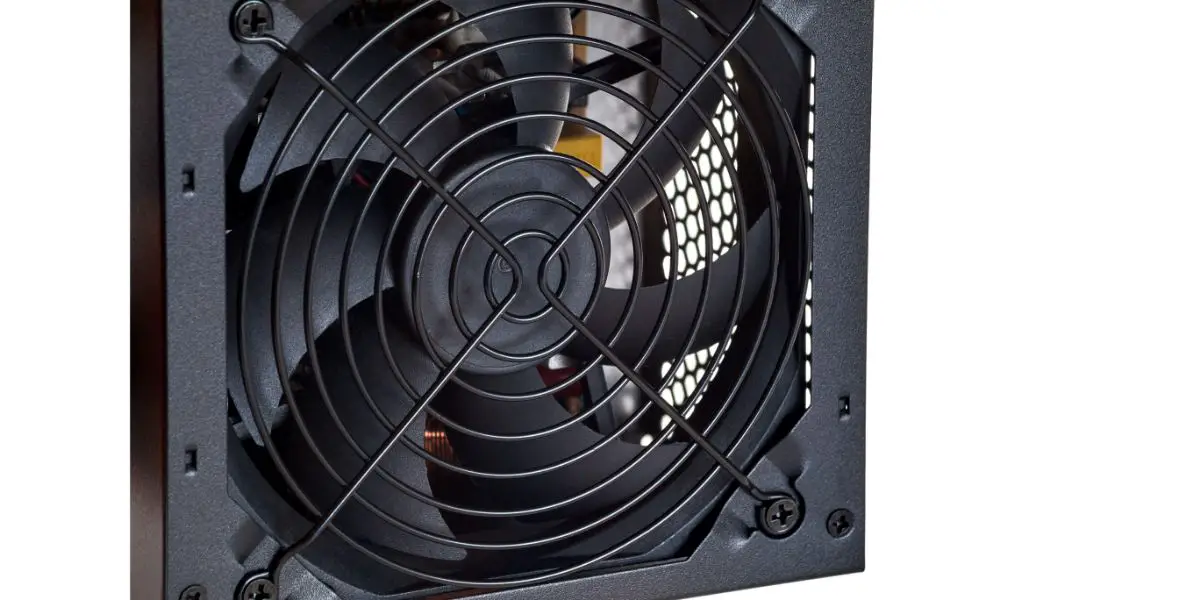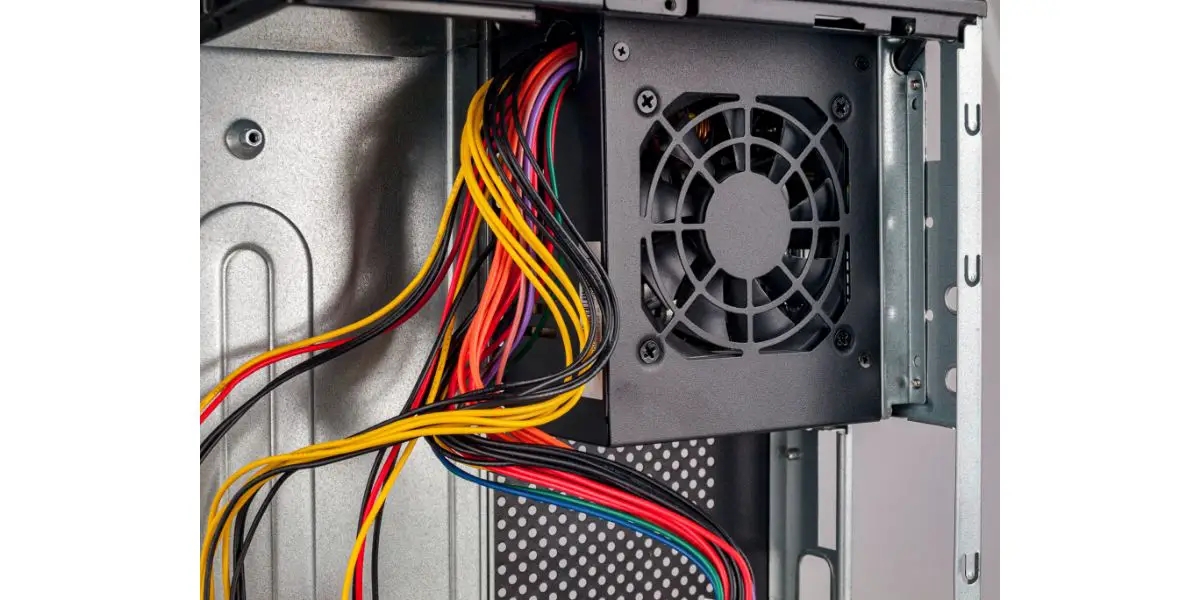Disclaimer: This post may contain affiliate links, meaning we get a small commission if you make a purchase through our links, at no cost to you. For more information, please visit our Disclaimer Page.
A power supply fan should always be running. Most power supply units (PSUs) are actively cooled, meaning their fans always run, so the PSU doesn’t overheat.
In this article, we’ll discuss why power supply fans constantly run and the factors that affect fan performance.
Table of Contents
Here’s Why Your Power Supply Fan Runs Constantly
Your power supply fan runs constantly to prevent your power supply from overheating during operation. While other fans within your computer may turn on and off to regulate temperature, the operation of PSU fans is to preemptively cool the power supply before it reaches a threshold temperature.
Because PSUs handle the most power of any component within your computer, they are the most likely to overheat and require the most cooling power during operation. To account for this, PSUs are designed with fans that always operate.
Most power supply fans are designed to stay on at constant or variable speeds. Power supply units (PSUs) function by drawing alternating current (AC) from your home and transferring it into direct current (DC) for parts within your computer.
However, some newer PSUs are semi-passive, and their fans turn off when the computer is idle. These fans activate when you turn them on and use your PC.
How Different Power Supply Fans Cool Your Computer
In the past, all PSU fans ran at a constant rate to ensure the power supply remained at an adequate temperature. However, a user experience (UX) issue with this feature was the noise that constantly running fans generate. Nowadays, PSU systems are actively or semi-passively cooled, and both types have advantages for your computer and user experience.
Varying-Rate Fans
To account for the unwanted noise, many PSU models now come with fans that spin at varying rates to reduce the total noise they produce during minimal performance tasks. These fans have a temperature sensor that modulates fan speed to reduce noise while maximizing airflow.
Systems with varying-rate fans cost more but are becoming the go-to choice for gamers and video designers because of the enhanced UX these fans provide.
For example, a varying-rate fan will remain perceptibly quiet while you browse the internet but get louder once you begin gaming.
Some state-of-the-art PSUs also have a feature that stops your PSU fan when a computer is idling to remove the noise it generates. However, even with this feature, these fans will run consistently once you use your computer.
Active Cooling Power Supply Fans
Actively cooling systems always have a fan running, even when a computer is idle, as long as the computer is powered on. Most PSUs will be actively cooled and have a fixed or varying rate.
Fixed-rate fans are cheaper and more common but only spin at one speed while your computer is powered. You can depend on these systems to cool your PC, but they will produce the most noise during computer use, especially gaming.
Semi-Passive Power Supply Fans
Semi-passive cooling systems turn off when a computer is idle or at very-low performance and spin at varying rates to cool the PSU at higher performance.
To maximize the UX of heavy computer use, many gaming PCs use semi-passive cooling to reduce the total noise of their systems.
These fans will remain off or turn off when the computer is idle or below a threshold temperature. At higher temperatures, they function as varying-rate fans. This system is also known as a 0-rpm mode on some models because of their capability to turn off during PC use.
Overall, semi-passive systems provide the best experience but will cost more than other PSU fans.
When Should a Power Supply Fan Not Be Running Continuously?
A power supply fan shouldn’t be running continuously only when you’re using a semi-passive system while your computer is at low performance.
Power supply fans should always be running while using your computer unless you have a 0-rpm feature enabled to reduce noise. If you don’t have a semi-active cooling system and your PSU fan isn’t spinning, there may be an issue with your PSU fan.
What Affects the Performance of a Power Supply Fan?
Because most PSU fans run constantly, they are subject to performance issues and degradation over time. While PSU fans should always be running (unless semi-passive), fans that fail to run or have trouble keeping up may indicate replacement in the future.
Here are factors that affect your PSU fan performance, with maintenance tips to promote longevity.
1. Type of Power Supply Fan
The type of power supply fan will have the most significant impact on its performance.
Actively cooled systems will degrade faster than semi-cooled systems because of their constant use. Further, fixed-rate systems will degrade faster than varying-rate systems for the same reason.
Generally, your fan should be quiet during minimal use and louder during high performance. If the fan stops working or becomes significantly loud, you may need a replacement.
2. Power Supply Load and Temperature
Fans will be louder and spin more at higher temperatures or power consumption. The more a fan runs at high temperatures, the faster it will lose its performance and begin to degrade.
While PSU fans allow computers to perform with large power loads during frequent use, such as several hours-long gaming sessions, it can wear down the fan and decrease performance over time.
3. Dust Accumulation
The accumulation of dust lowers performance and decreases airflow for your system. Dust on the fan blades will increase their load and require more power.
Furthermore, dust on the intake grill of your PC will prevent airflow and lower your system’s efficiency. I recommend cleaning the dust off your computer every 3 to 6 months to maximize performance.
4. Age
Power supply units typically last 5 to 10 years under the right conditions and then begin to have significant performance issues. Inoperative PSUs can overheat or malfunction, possibly damaging other parts of your computer.
While PSUs have incredible longevity, they won’t last forever. If your PSU fan becomes excessively noisy or stops spinning during use, it may be time to replace the entire PSU.
When To Replace a Power Supply Fan
If your power supply fan is beginning to falter or stall, it may be time to replace it or the entire unit. You should replace your power supply fan when it stops working or makes significant noise during operation.
Additionally, you should replace your entire power supply unit if:
- Your computer fails to start.
- Your computer often unexpectedly shuts down under high power loads.
- Your computer has issues with its GPU or other high-power systems (such as speed port charging).
- Your PSU has been in operation for ten or more years.
If you’re unsure whether your current PSU is reaching its expected lifespan, I recommend taking it to a computer specialist who can diagnose the health of your PSU and suggest the best options.
The Bottom Line
In general, PSU fans are always running to ensure your power supply doesn’t reach a critical temperature, which can harm other components of your computer. While some PSUs have a semi-passive cooling system where the fan remains off during low power loads, these systems kick on when your power supply begins to generate heat.


